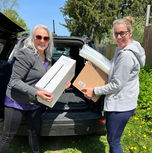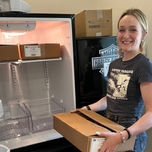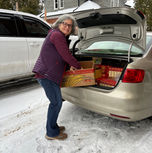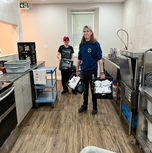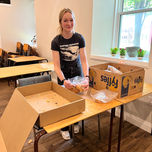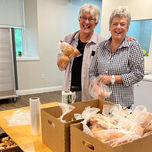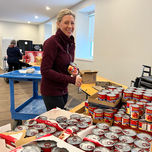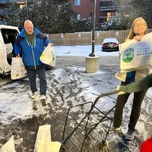
Feeding people costs less than treating them for chronic diseases.
The VanDyck Foundation has launched a new website! Visit us at: www.vandyckfoundation.com to see what we're up to.
Delivery day operations
The following details the processes that took place to get fresh food from Barrie’s Foodshed to inside the homes of hungriest and most food-insecure residents.
Ordering Fresh Food
Recipients of the Fresh Food Weekly program could pick and choose meal box food items they did and did not want to receive in each biweekly meal box delivery. Recipients did this by submitting an online Food Order Form for each meal box they received. This was our January 16th food order form. Feel free to fill it out. However, the automated confirmation email has been re-assigned to another email trigger, so you won't receive an email upon submission.
Once program recipients filled out their food order form, it was received in a chart, which could be downloaded to a CSV file and uploaded to a spreadsheet.

This is how we tallied the food orders, so we knew how many units, or pounds, etc., to order with food suppliers and donors. Furthermore, extra items for each food item needed to be ordered as well. Sometimes a litre of milk would tear during transportation, or a Packer might accidentally give a recipient Mild Gouda cheese when they asked for Cheddar, etc. If extra items aren’t ordered, it causes a ripple effect of unavailable items during the packing process; i.e., there’s one less Mild Gouda so the next Packer takes the Jarlsburg when it runs out, and so on and so forth. Depending on how many units are ordered in total, bulk orders should always include one to three extra units per food item for orders of 60-100 units.
Automated Confirmation Emails
An automated email from Wix was also generated after recipients submitted their biweekly food order forms:

Another email was triggered to Leah’s phone, and listed each recipient’s food order in written form:
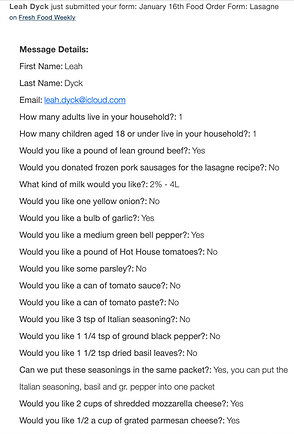
Packer Food Order Forms
This information was then used to fill-out the Packer Food Order Forms. Here’s an example of the packer form for the ‘Bourbon Maple Glazed Salmon Meal Box Meal Kit’:
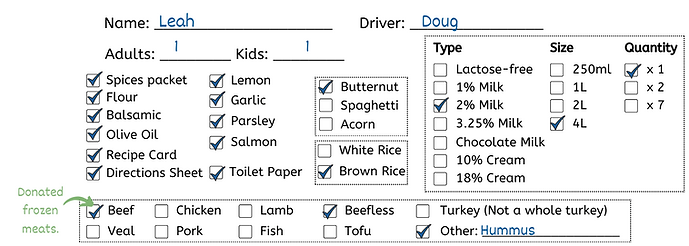
As you can see, although this example form was filled out on the computer, it was filled out by hand during the program, which had eventually become a very time-consuming task.When the meal box delivery program launched in June 2022, it was monthly and had 50 on-going recipients on it, and this number just kept increasing.
Food System Development
Here's an example of a food system in Barrie, Ontario that Fresh Food Weekly created for our meal box delivery program. Here, we have some of our main and local food suppliers, as well as some of our main and local food donors within the vicinity of this screenshot.

On the morning of each delivery day, our volunteers would go pickup our wholesale orders or bulk donations and bring them to our operating facility (a church basement). This location could also be called a fulfillment facility since it's where all the food is brought to be individually packaged (if needed), and packed into individual meal boxes to be picked-up by volunteers and then delivered to program recipients.
Plan-o-grams
We started creating plan-o-grams to ease the drop-off of bulk orders from pickup volunteers. On the morning of delivery days, volunteer pickup drivers could easily view the plan-o-gram to find out where they should put the food after they picked it up and arrived with it at the fulfillment space (the church basement). Implementing the plan-o-gram ended up reducing a significant amount of unnecessary heavy-lifting.

Additionally, the use of table signs indicating which food item to be placed on it, also helped make the process of dropping off the bulk food easier for the volunteer pickup drivers.

System Processes Become More Efficient

In November 2023, the program’s deliveries were occurring biweekly and the number of biweekly on-going recipients had increased to 90, and this is when Lindsay Murphy joined the scene to provide systems processing support. Lindsay works for Prodomax Automation Ltd., here in Barrie, and one of the first things she wanted to try was printing off the individual food order forms triggered directly to email, which significantly reduced the time Leah was spending writing them out. However, all the volunteer packers, including Leah herself, said this form took longer to read while doing the packing, and made packing longer to do. Interesting, right? Who would have thought that legibility would have played such a big role in the amount of ease it took to fulfill food order forms?
Receiving Fresh Food
Once food was picked up from suppliers and brought to the church, it was placed strategically around the fulfillment room in the same order the food was listed on the ‘Packer Food Order Form’.
When Lindsay arrived, one of the things she wanted to do was physically move the tables in the room to create a half circle. Previously, food was placed on tables that were in a class-room style setup of rows, simply because the space we rented was a church basement and the church rented to other organizations and we pretty much used the tables in whatever way the last renter left them in.

Tre Sorelle

Fox's Bakery

Costco

Alliston Creamery

Lindsay then reached out to Hercules Sealing Products here in Barrie and received a donation of five heavy-duty industrial utility carts so the volunteer packers could use them to collect food items and push the cart around the half circle to assist.


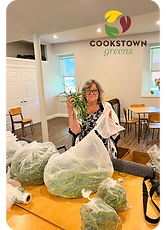




All Food On Deck!
Additionally, Lindsay started bringing the cold items out of the fridge, which created a volunteer position: Replenisher; which are volunteers who replenish the table with cold items.

These combined changes transformed the packing process by night and day, and reduced our packing time by a full hour. By the time Lindsay had fully implemented her changes, we were able to pack around $5K worth of food into 90 meal boxes in an hour and a half.

Additionally, if the program had continued longer, she likely would have figured out further ways to reduce the packing times - it’s just the way her mind works. In fact, the last thing we asked her for help with right before closing down the program was re-designing the delivery bags from Tempo Flexible Packaging because we needed to order more. We asked her to see if she could figure out a way to make the bags sized to fit specific food items by the following packaging categories:
-
A cold bag
-
A meat bag (for frozen and fresh)
-
A produce bag
-
A dry bag
Additionally, we could use cardboard boxes from Moore Packaging for any of these "bags" as well. One of the things Leah had requested feedback from Lindsay on was whether we should combine the bread box with an egg box (bread on top; eggs on bottom, and separated by a "floor"), since these two items are similar in length and width. However, we realized that many program recipients are single-adult households and wouldn't consume 12 eggs a week, but they would consume one loaf of bread a week. Although the program isn't running right now, we have always known that it needed to expand because the need for it is so great. We need to expand and that's why we're seeking substantial financial funding so we can operate this program properly.
Bagging
When food is sourced in bulk, it sometimes requires labour support to re-package it into smaller, individual portions, or just to package it period. For example, all of our lettuce heads come in cases of 24.

Once it was received, it was bagged into bags perfectly-sized for each type of lettuce head. This is all part of the food safety and handling process, and also takes into consideration the likelihood that recipients don’t have adequate food storage at home such tin foil, plastic wrap, zip loc bags or Tupperware.
Packing Fresh Food
Packing
One of the good things about volunteering for Fresh Food Weekly was that volunteers usually weren’t required to volunteer for longer than two hours at a time. Of course, on holiday meal box delivery days such as Christmas, Thanksgiving and Easter, there was always more to do in the same small-ish space, and workloads were always increased. We had to rent a cooler trailer from Secure Store in Barrie, on those delivery days, and that meant having meal boxes - which are technically heavy-duty, recyclable bags - labeled as the following:
-
Cold bags
-
Dry bags
-
Produce bags

On the regular, on-going delivery days, though, we tried to keep delivery bag weights down to a total of 20 pounds among them all, per household, although that was impossible with families who had lots of children.
Packing Stations
Each packer volunteer had their own packing station. Packing stations included a 6-foot by 3-foot table, and:


Another wonderful idea by Lindsay was to start utilizing a ‘Picker’ and a ‘Packer’ volunteer-pair to pack the meal boxes. The Picker volunteer would use the utility cart to pick the food items around the half circle, while the Packer volunteer would use the table to pack the meal boxes. Lindsay then decided to have Carrier volunteers, and Loader volunteers. Just like it sounds, the Carriers, which were usually teenagers or men (often fathers of teens or husbands of packers), would carry the packed meal boxes outside to the loading zone. When a volunteer driver arrived to pickup their deliveries, a Loader volunteer would help them load their vehicle upon pulling up.



Delivering Fresh Food
Packing Stations
Another idea Lindsay had was to decrease the size of the packing station’s tables, in order to create more space for the utility carts to move:

However, the purpose of having a Picker was to save the Packer time by allowing them to only focus on labeling and packing bags; and when carts were unloaded onto the packing station, there wasn’t enough space left on the table for anything.



The size of the table needed to be big enough to hold all the items that would go in all the bags as well as leave enough space for the Packer to move her arms around, and fill each bag, one at a time. A pool-table-sized countertop at standing-level would be the ideal table size for Packers to pack meal boxes on.
Delivery Driver Arrivals
Volunteer delivery drivers were each assigned a different arrival time to arrive at the fulfillment centre and pickup their delivery route’s meal boxes. Before Lindsay arrived, delivery drivers were scheduled to arrive every five to 10 minutes between 4:00PM and 5:30PM, depending on how many drivers there were. Leah had always planned to stretch all the drivers to arrive between this time frame to accommodate the volunteer’s schedules. However, one of the reasons Lindsay reached out in the first place was because Leah posted on Facebook asking for help with reducing her workload. One of the ways we decided to do this was by scheduling all delivery drivers to arrive in five-minute intervals between 4:00PM and 5:00PM. Packers usually finished by 4:30PM and at that time, would gather the extra food for a final volunteer pickup driver to take to the local charity of their choosing.



For the last six months of the program at least, our wonderful volunteer Debbie O’Neill had been delivering tons of our extra food and dropping it off to the Troy Scott Community Fridge, as well as to a low-income senior’s home in Innisfil, Ont.
The Power of Community
Fresh Food Weekly relied on volunteers to run the charitable activities - from picking up food, to gleaning fields, to packaging donated foods, to packing meal boxes and delivering them to the front doorsteps of recipients.
This was accomplished by using social media.
At the beginning, it was literally chaos (see video above)
Extra Volunteers For The Holidays
For holiday delivery days, we always needed a lot more volunteers than usual because we always raised extra funds so we could give out one-time holiday meal boxes to additional low-income families. By Christmas 2023, we needed ‘financial volunteers’ because Fresh Food Weekly received +1,000 applications for our Christmas dinner meal boxes.

Volunteering programs generate real life experiences. They build character, strengthen community and they create a culture of strength in numbers. Volunteering in groups teaches us that together, we can make our world a better place and alleviate the suffering of others.


















